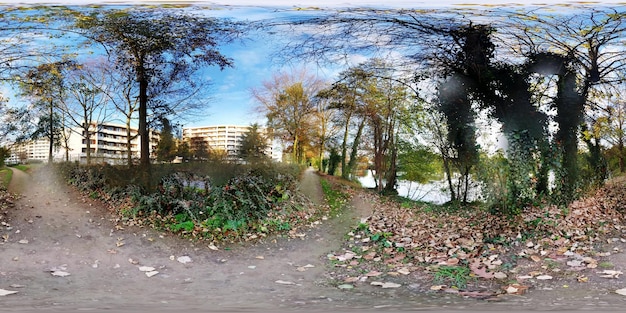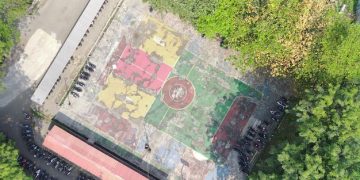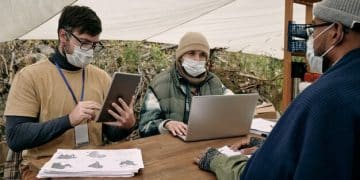Neighborhood Cleanup: Boosting Property Values by 5% in 6 Months

Neighborhood cleanup projects can increase property values by 5% in 6 months through enhanced curb appeal, improved community safety, and a greater sense of pride.
Can a neighborhood cleanup project actually boost property values? Absolutely! Discover how can a neighborhood cleanup project increase property values by 5% in 6 months through community action and visible improvements.
Why Neighborhood Cleanups Matter for Property Values
Neighborhood cleanup projects are more than just about aesthetics; they’re about creating a sense of community, safety, and pride. These factors can directly impact property values, making neighborhoods more attractive to potential buyers and residents.
Let’s delve into how these initiatives can lead to a tangible increase in property values within a relatively short timeframe.
Improved Curb Appeal and First Impressions
Curb appeal plays a significant role in attracting potential buyers. A clean and well-maintained neighborhood creates a positive first impression, making homes more desirable.
Think of it as staging your entire neighborhood! When potential buyers drive through, they’re not just looking at individual homes; they’re evaluating the whole package.
Enhanced Community Safety
Clean neighborhoods often experience lower crime rates. Regular cleanup efforts deter vandalism and other illegal activities, making the area safer for everyone.
When a neighborhood looks cared for, it sends a signal that residents are invested in their community.
- Reduced Crime: Cleanliness discourages criminal activity.
- Safer Environment: Eliminating hazards reduces accidents.
- Community Solidarity: Residents working together fosters unity.
- Positive Perception: Attracts families and responsible residents.
Boosting property values is a direct effect of improved safety, especially for new home buyers.

Planning and Organizing a Successful Cleanup Project
A successful neighborhood cleanup project requires careful planning and organization. From setting clear goals to mobilizing volunteers, every step is crucial.
Here’s a breakdown of how to plan and execute a cleanup project that yields both immediate aesthetic improvements and long-term value.
Define Clear Goals and Objectives
Start by identifying specific areas that need improvement and setting measurable goals. This could include removing litter, planting trees, or improving public spaces.
Having clear objectives helps you stay focused and track your progress.
Recruit Volunteers and Build Partnerships
Engage residents, local businesses, and community organizations to maximize participation. A strong volunteer base is essential for sustaining the project.
Reach out to local schools, churches, and community centers to find potential volunteers.
- Local Businesses: Partner for supplies and sponsorships.
- Community Organizations: Collaborate for resources and support.
- Schools and Churches: Engage students and members.
- Social Media: Use it to spread the word and rally participation.
Engaging residents and securing partnerships leads to sustainable initiatives.
Measuring the Impact: Data and Observations
To demonstrate the effectiveness of a neighborhood cleanup project, it’s essential to collect data and make observations before, during, and after the initiative.
This data can help quantify the impact on property values and community perception.
Before and After Comparisons
Document the neighborhood’s condition before the cleanup begins. Take photos, videos, and notes on areas with high litter levels, overgrown vegetation, or signs of neglect.
After the cleanup, repeat the documentation process. Compare the “before” and “after” images and data to highlight the improvements.
Track Property Values and Sales
Monitor local real estate data to identify changes in property values and sales activity. Look for trends that correlate with the timing of the cleanup project.
Work with local real estate agents to gather insights and data on market trends.

Maintaining Momentum: Sustainability is Key
Sustaining the positive impact of a neighborhood cleanup project requires ongoing maintenance and community engagement. One-time efforts are valuable, but lasting change comes from consistent action.
Here are strategies to ensure the project’s benefits endure over time.
Establish Regular Maintenance Schedules
Create a schedule for ongoing cleanup activities, such as weekly litter pickups, monthly landscaping, and seasonal planting.
Consistent maintenance prevents the neighborhood from reverting to its pre-cleanup condition.
Create a Community Watch Program
A community watch program involves residents actively monitoring and reporting any issues or concerns in the neighborhood. This can include illegal dumping, vandalism, or maintenance needs.
This helps to keep the neighborhood clean and safe consistently.
- Visible Presence: Deters illegal activities.
- Swift Reporting: Addresses maintenance needs promptly.
- Community Ownership: Encourages shared responsibility.
- Collaborative Spirit: Fosters a strong neighborhood bond.
A steady community watch program supports keeping neighborhoods clean and safe, reinforcing property values.
Financial Incentives: Grants and Funding Opportunities
Securing funding is essential for supporting neighborhood cleanup projects and ensuring their sustainability. Grants and funding opportunities can provide the necessary resources to purchase equipment, supplies, and hire staff.
Start by researching local, state, and federal programs that offer grants for community improvement projects.
Federal and State Grants
Explore federal and state government agencies that offer grants for environmental cleanup, community development, and neighborhood revitalization.
These grants often have specific eligibility requirements and application processes.
Local Government and Foundations
Contact your local government and community foundations to inquire about funding opportunities. Many cities and counties have programs specifically designed to support neighborhood improvement projects.
Local funding sources are often more accessible and tailored to the specific needs of your community.
The Ripple Effect: Community Pride and Engagement
Neighborhood cleanup projects have a ripple effect, extending beyond just aesthetic improvements. They foster community pride, increase resident engagement, and create a more welcoming environment for everyone.
Community pride often translates into increased civic participation and a stronger sense of belonging.
Building Stronger Communities
When residents work together to improve their neighborhood, they develop stronger bonds and a greater sense of community.
This collaborative spirit can lead to positive social dynamics and a more cohesive neighborhood.
Attracting New Residents and Businesses
A clean and well-maintained neighborhood is more attractive to potential residents and businesses. This can lead to increased property values, economic growth, and a higher quality of life for everyone.
New businesses create jobs, generate tax revenue, and provide valuable services to the community.
| Key Point | Brief Description |
|---|---|
| ✨ Curb Appeal | Enhances first impressions, making properties more attractive. |
| 🛡️ Community Safety | Discourages crime and vandalism, improving perceived safety. |
| 🤝 Volunteerism | Boosts community engagement and pride through participation. |
| 💰 Grants | Securing funding helps sustain long-term cleanup efforts. |
Frequently Asked Questions
▼
Ideally, organizing a major cleanup twice a year, supplemented by smaller, monthly efforts, can maintain cleanliness and community engagement. This provides a balance between intensive clearing and consistent upkeep.
▼
Essential supplies include trash bags, gloves, safety vests, first-aid kits, and tools like rakes and shovels. Having these items ensures both efficiency and safety for all volunteers involved.
▼
By removing debris and clearing overgrown areas, cleanup projects eliminate hiding spots for potential criminal activity. This increased visibility deters crime and fosters a safer environment for residents.
▼
Local businesses can contribute by providing funding, supplies, or volunteer support. Their involvement demonstrates commitment to the community, enhancing the cleanup project’s impact and reach.
▼
Track effectiveness by documenting the areas before the cleanup, noting the amount of trash collected, and observing any improvements in community perception and safety. This data demonstrates tangible outcomes.
Conclusion
In conclusion, a well-planned and executed neighborhood cleanup project can lead to a noticeable increase in property values within six months. By focusing on curb appeal, community safety, and sustainable maintenance, residents can create a more attractive and desirable neighborhood for everyone.





